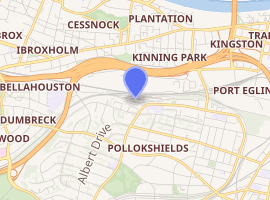Glasgow Shields Road TMD
Glasgow Shields ETD is a railway Electric Traction Depot in Glasgow, Scotland. The depot is located on the south side of the Glasgow Central to Paisley lines, adjacent to Shields Junction, close to the site of the former Shields Road station. The depot's code is 'GW'.
.jpg) EMUs outside the depot | |

| |
| Location | |
|---|---|
| Location | Glasgow, Scotland |
| Coordinates | 55.8469°N 4.2873°W |
| OS grid | NS568638 |
| Characteristics | |
| Owner(s) | Network Rail |
| Depot code(s) | GW (1975-)[1] |
| Type | Electric, EMU |
| History | |
| Opened | 1967 |
| Original | British Railways |
| Former depot code(s) | GS (1973-1975)[1] |
History
The depot was opened in May 1967 by the Minister of Transport, the Rt. Hon. Barbara Castle MP. Initially to maintain the Class 303 and Class 311 rolling stock operating on the electrified services from Glasgow Central High Level to Gourock, Wemyss Bay, Motherwell via Rutherglen and also the Cathcart Circle and Kirkhill Branches. Electrification up until this point had been confined to Cathcart Circle and Newton/Neilston branches (May 1962) and the North Suburban lines (1960) with sets being maintained at Hyndland Depot which opened in 1959.
In 1974 with the further extension of the West Coast Main Line electrification to Glasgow Central meant that AC Electric locomotives would be running the entire route from Euston to Glasgow. The decision was made to maintain the locos at Shields while the coaching stock was maintained at nearby Polmadie Depot.
The original allocated locomotives were the Class 81 fleet. Visiting classes ranged from Classes 85, 86 and 87 locos, ultimately seeing the Class 90 introduced in the late 1980s.
In its original guise, the depot was capable of handling 8 × 3-car sets in four roads undercover. It had seven stabling roads. Within the depot itself Matterson lifting jacks were used to allow the changing of wheelsets and traction motors. Also a wallcrane for the removal of pantographs and other associated roof equipment from the fleet. The depot also had an underfloor wheel profiling machine located in a separate shed in No. 7 road.
The depot was also the original home of the CM&EE electrification maintenance train and the OHL maintenance staff prior to moving to the purpose built Network Rail facility at Cowlairs.
In 1978 the depot saw its first expansion as British Rail decided to base the Class 370 Advanced Passenger Train at the depot. Part of the expansion saw the extension of the maintenance shed by fully three coach lengths to allow for the additional passenger rakes into which the APT was formed. Additional equipment was installed including a 15 tonne overhead crane, a purpose built wheel drop pit for removing the axles on the articulated bogies of the APT.
In 1985 the decision was made to scrap the APT and BR announced a consolidation of its EMU maintenance in Scotland, this led to the closure of Hyndland Depot in 1987 as a maintenance facility. Furthermore, a purpose built facility was opened at Yoker allowing the closure of Bridgeton as a stabling point also.
This meant that the depot at Shields was now responsible for all the EMU maintenance in the Glasgow area. All fleets were maintained by the expanded staff who had transferred. The Class 314 and Class 303 EMUs were transferred from the north of the city to the depot by means of a connecting line just west of Rutherglen station.
Around 1990, a further development saw the withdrawal of the electric loco fleet to Polmadie. This left Shields with a 'captive' fleet to maintain. By now this fleet had been enhanced by the introduction of the Class 318 EMUs for the newly electrified Ayrshire lines and by the Class 320 fleet for the North Clyde services. Both of which were commissioned out of the depot. As the life expectancy of the Class 303 fleet diminished, a fleet of Class 334 Juniper EMUs were commissioned again by Shields and fully introduced in 2002.
The depot also maintained the Royal Mail Class 325 dual voltage EMUs in partnership with Selhurst Depot in London prior to being mothballed in 1999.
Following an announcement by Transport Scotland of the order of a new fleet of Class 380 EMUs a £24m expansion of the depot got underway. This included a dedicated 3-road maintenance shed to the east of the existing building. This was for the exclusive use of the new sets. also housed within the building were new office accommodation and stores.
As part of the expansion a new state of the art wheel lathe was also installed enabling faster re-profiling of rolling stock wheelsets.
Allocation
The allocation comprises the following ScotRail stock:
- Class 318 EMUs (21 sets, since 1986)
- Class 320 EMUs (22 sets, since 1990)
- Class 334 EMUs (40 sets, since 2000)
- Class 380 EMUs (38 sets, since 2010)
- Class 385 EMUs (70 sets, since 2020)
The depot was formerly home to:
- Class 81 electric locomotives (1975-1990)
- Class 303 EMUs (1975-2002)
- Class 305 EMUs (1991-2001)
- Class 311 EMUs (1975-1993)
- Class 314 EMUs (1987-2019)
- Class 322 EMUs (2001-2011)
- Class 325 EMUs (1996-1999)
- Class 370 Advanced Passenger Train-Prototype (1981-1985)
References
- "The all-time guide to UK Shed and Depot Codes" (PDF). TheRailwayCentre.com. 5 May 2006. Archived from the original (PDF) on 17 December 2013. Retrieved 26 August 2016.
- Baker, S.K. Rail Atlas Great Britain & Ireland. ISBN 0-86093-553-1.